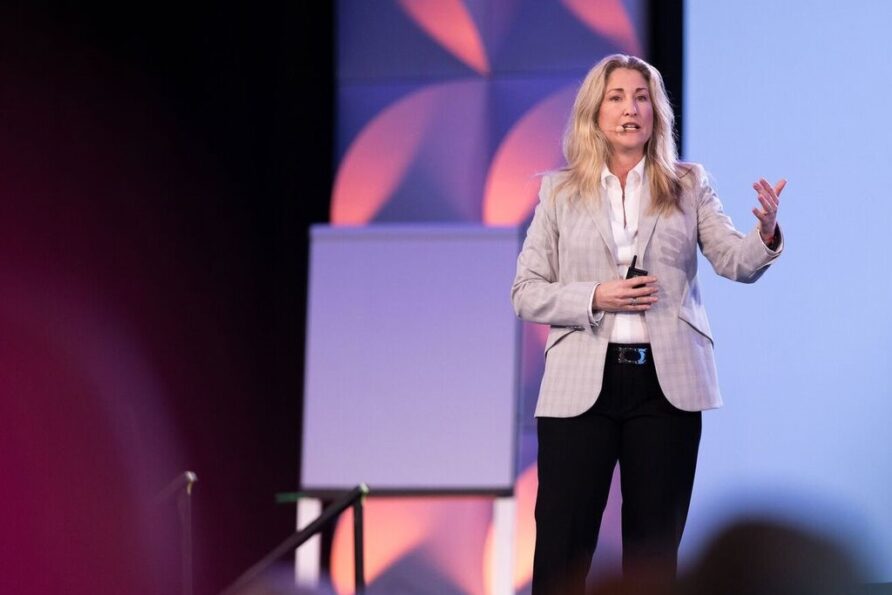We help you get everyone on board.
Growth IQ in B2B marketing and sales

Tiffani Bova is a growth and innovation evangelist at Salesforce, one of the world’s leading tech companies. Tiffani sets out a new, proven framework for business leaders looking to pursue growth. She claims that there are only ten growth paths and she focuses on the mental game of growing a business. On March 19th, 2019 Tiffani will be speaking at the B2B Marketing Forum in The Netherlands. In this article, you will read more about the growth paths to success and the role of marketing and sales professionals in B2B.
Growing in sales and marketing is a mental game
Tiffani recently published the Wall Street Journal Bestseller ‘Growth IQ’. Her story opens doors for new ideas and new actions. The book is about growing business and is a must-read for business owners as well as sales and marketing professionals. Tiffany wanted the title to be short, one or two words only: “I didn’t want to use the word ‘Sales’ in the title, as I felt it would be too limiting. For me the word ‘Growth’ is a way to encapsulate all sorts of topics and the word ‘IQ’ supports the fact that I believe growth is a thinking game more than anything else.”
Need help with internal adoption?
Game Changers in B2B
“We have no control of information consumption anymore”
In the context of growth, the biggest game-changer in the past years is about leveling the playing field of buyers to real-time information. Information is everywhere. Tiffani used to be a sales rep and sales manager herself. She explains: “We have no control of information consumption anymore; ultimately it is a matter of what can we take off our plates that customers can do themselves. Cases, webinars, demos, it can all be found online without the need of a sales rep.”
Tiffani describes MARTech as another game-changer: “We have also seen a shift in IT spending. CMO’s today are gradually spending more on IT than the IT organization. Digital Marketing has claimed a much bigger role in customer-facing technologies.”
B2B and B2C can learn a lot from each other
“I would rather talk about B2E, Business to Everyone, Everything and Every Experience”
When it comes to differences in the chosen growth strategies between B2B and B2C companies, Tiffani sees that the lines are blurring: “On the one hand buying behaviour of consumers has changed dramatically and you see those very same consumer behaviors making their way into the (sometimes) more complex business buying cycle, even though decisions are being made by groups of people rather than by a single individual.”
Tiffani: “Whether you are in sales, marketing, customer service or product design, B2B and B2C can learn a lot from each other. Take Salesforce as an example: Can CRM buying be as easy as buying a book from Amazon? When the attention span of a buyer is 90 seconds, this means that topics such as the user interface, ease of use, design thinking are extremely important, equally important in B2B as in B2C. We have to ask ourselves: How can we make it easy for people to find information, interact with us and make them decide within hours?”
Looking at (customer) growth, what is the role of marketing?
“I am a recovering seller”, so says Tiffani, “and I have seen how marketers have been trying to gain more control over customer journeys and exerting more influence over the way companies ‘sell,’ but for many, that is where it stops. Rarely do I see marketing organizations taking on a quota, which it is responsible for delivering. For sales reps this is normal, quota-carrying simply means that every salesperson is expected to achieve a certain amount of sales. But for marketers, this usually is a bridge too far. Supporting and enabling sales is a different business proposition than being responsible for revenue generation. Unfortunately, I still see a big gap between sales and marketing.”
“Marketers are interested in what they are measured on like lead generation”
Tiffani elaborates on the gap between customer-facing organizations and B2B. Because in customer-facing companies it doesn’t stop at sales, and marketing – it includes customer service. Therefore, these three groups working in a more collaborative fashion are the trifecta for growth. Thus, marketers must begin to expand ‘sales enablement’ beyond the sales department to include customer service agents.
It happens already in customer-centric companies like Apple and Zappos, where sales, marketing, and customer service are not only organized to work more closely, but they share metrics that drive customer-centric behavior. Creating a few shared metrics, like Net Promoter Score or Customer Satisfaction, is a great way to break down existing silos and empower teams to serve customers better, ultimately improving the customer experience.
What are the biggest take-aways for marketers from the Growth IQ story?
- Understanding the reality that the lines between B2B and B2C are blurring
- Focusing on improving the customer experience
- Clsoing the gap between sales, customer service and marketing
- Looking at the buyer journey and sales process as two very different activities
How do B2B marketers stay ahead of the game?
“Don’t try to own it all”
Tiffani: “Everyone should have a well understood role in delivering a compelling customer experience and marketers should worry less about ‘owning’ things. Instead marketers should worry more about what impact decisions from the various (customer facing) teams have on your customers. When you talk about being customer-led or customer centric, you must take a step back and consider the consequences of everything you do. Stop trying to justify the budget with metrics that are not customer focused! That’s why I put customer experience, CX, as growth path 1 in my book. This should be the backbone of everything you do!”
Share this article
Related insights
Grow your B2B Marketing knowledge
Subscribe to keep up with our latest B2B Marketing updates and exclusive events. Straight to your inbox, once a month.



